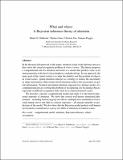| dc.contributor.author | Chikkerur, Sharat | |
| dc.contributor.author | Serre, Thomas R. | |
| dc.contributor.author | Tan, Cheston | |
| dc.contributor.author | Poggio, Tomaso A. | |
| dc.date.accessioned | 2011-06-22T15:57:31Z | |
| dc.date.available | 2011-06-22T15:57:31Z | |
| dc.date.issued | 2010-10 | |
| dc.date.submitted | 2010-04 | |
| dc.identifier.issn | 0042-6989 | |
| dc.identifier.uri | http://hdl.handle.net/1721.1/64647 | |
| dc.description.abstract | In the theoretical framework of this paper, attention is part of the inference process that solves the visual recognition problem of what is where. The theory proposes a computational role for attention and leads to a model that predicts some of its main properties at the level of psychophysics and physiology. In our approach, the main goal of the visual system is to infer the identity and the position of objects in visual scenes: spatial attention emerges as a strategy to reduce the uncertainty in shape information while feature-based attention reduces the uncertainty in spatial information. Featural and spatial attention represent two distinct modes of a computational process solving the problem of recognizing and localizing objects, especially in difficult recognition tasks such as in cluttered natural scenes.
We describe a specific computational model and relate it to the known functional anatomy of attention. We show that several well-known attentional phenomena – including bottom-up pop-out effects, multiplicative modulation of neuronal tuning curves and shift in contrast responses – all emerge naturally as predictions of the model. We also show that the Bayesian model predicts well human eye fixations (considered as a proxy for shifts of attention) in natural scenes. | en_US |
| dc.description.sponsorship | United States. Defense Advanced Research Projects Agency (FA8650-06-C-7632) | en_US |
| dc.description.sponsorship | United States. Defense Advanced Research Projects Agency (FA8650-09-1-7946) | en_US |
| dc.language.iso | en_US | |
| dc.publisher | Elsevier B.V. | en_US |
| dc.relation.isversionof | http://dx.doi.org/10.1016/j.visres.2010.05.013 | en_US |
| dc.rights | Creative Commons Attribution-Noncommercial-Share Alike 3.0 | en_US |
| dc.rights.uri | http://creativecommons.org/licenses/by-nc-sa/3.0/ | en_US |
| dc.source | Prof. Poggio via Lisa Horowitz | en_US |
| dc.title | What and Where: A Bayesian inference theory of visual attention | en_US |
| dc.type | Article | en_US |
| dc.identifier.citation | Chikkerur, Sharat et al. “What and Where: A Bayesian Inference Theory of Attention.” Vision Research 50.22 (2010) : 2233-2247. | en_US |
| dc.contributor.department | Massachusetts Institute of Technology. Center for Biological & Computational Learning | en_US |
| dc.contributor.department | Massachusetts Institute of Technology. Department of Brain and Cognitive Sciences | en_US |
| dc.contributor.department | McGovern Institute for Brain Research at MIT | en_US |
| dc.contributor.approver | Poggio, Tomaso A. | |
| dc.contributor.mitauthor | Chikkerur, Sharat | |
| dc.contributor.mitauthor | Serre, Thomas R. | |
| dc.contributor.mitauthor | Tan, Cheston | |
| dc.contributor.mitauthor | Poggio, Tomaso A. | |
| dc.relation.journal | Visual Research | en_US |
| dc.eprint.version | Author's final manuscript | en_US |
| dc.type.uri | http://purl.org/eprint/type/JournalArticle | en_US |
| eprint.status | http://purl.org/eprint/status/PeerReviewed | en_US |
| dspace.orderedauthors | Chikkerur, Sharat; Serre, Thomas; Tan, Cheston; Poggio, Tomaso | en |
| dc.identifier.orcid | https://orcid.org/0000-0002-3944-0455 | |
| mit.license | OPEN_ACCESS_POLICY | en_US |
| mit.metadata.status | Complete | |
